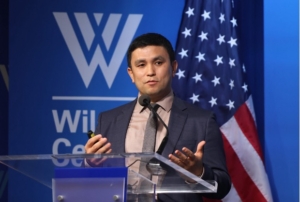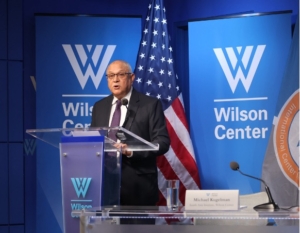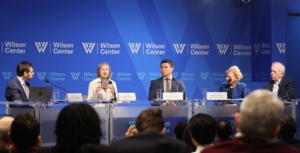The Sustainability Director of Ericsson, Matilda Gennevi Gustafsson stated at the just ended United Nations COP17 Climate Change Conference that “In order to meet the needs of the 9 billion people estimated to populate the world by 2050, there must be a shift from incremental to transformative solutions to solve climate change. The opportunity for the transformational power of ICT to put us on the path of a low-carbon economy and spur socio-economic development has never been greater.”
So as we enter 2012, we expect the rise of ICT applications and solutions with the potential to mitigate the impact of the global climate change on our environment. Below are 5 selected areas with specific examples to watch for transformative solutions as the year progresses:

Photo Credit: Travel Outback
1. ICTs for Weather Information
While farming remains a predominant occupation for the rural people across the developing world, the increasing effects of climate change is being felt in almost all areas of their farming activities. From shorter and unpredictable rainfalls patterns to increasing flooding, poor quality and quantity of forage for livestock the general changes in temperature. As a result, concerns and questions among farmers and to scientists about these unpredictable weather patterns in recent years continue to rise. The focus for the scientists now is to try and quickly response to these concerns from the farmers and ICT applications and solutions are expected to rise in this area as well.
a) Weather Information for Africa
This is an initiative by Ericsson which addresses the lack of quality weather forecasts in Africa. It assists national meteorological services to design customized forecasts and promotes the use of cellphones to distribute the information. Local weather information such as storm warnings not only enables disaster, but can also improve economic opportunities for the millions of people working in industries such as fisheries, agriculture and small business development. The initiative is already showing positive benefits which can be of use for the 3.5 million people living alongside Lake Victoria, Africa’s largest lake.
b) Using SMS to Fast-Track Responses to Farmers’ Climate Change Questions in Zambia
Example is seen in Zambia where climate change questions can now receive quick answers via SMS from a new feedback SMS system developed by the country’s National Agricultural Information Services (NAIS) together with, a local software developer, SMSize and International Institute for Communication and Development (IICD).
c) Using ICTs to Minimize Weather Hazards on Farmers
Also in Ghana, Ignitia is presenting a hands-on opportunity, where it can deliver daily weather forecasts and warnings to initially 90,000 farmers. The farmer gets a daily forecast in his/her mobile phone by an automatically generated text message, tailored to the farmer’s specific location by GPS coordinates.

Photo Credit: Eon
2. ICTs to Facilitate Connectivity and Commute
a) Virtual Meetings
In a not too distant future there may not be any travel agencies, only meeting agencies (where the default suggestion is a virtual meeting, and a physical meeting is booked only if necessary), the Global e-Sustainability Initiative (GeSI). The statement continues that virtual meetings may have started as a smarter way to do conferences, and this shift alone has resulted in significant reductions of GHG emissions, but virtual meetings could also help accelerate sustainable production around the world by increasing transparency.
b) Teleworking
Teleworking, according to the Global e-Sustainability Initiative (GeSI) is the possibility of working wherever is best and avoiding travel when you can get access to documents and information without it. It allows people to get things done in a much smarter way which not only saves time, money, and energy directly, but also promotes investments in an infrastructure that is very resource efficient. Much of today’s information and material can be stored in the “cloud” to allow access from any mobile device. Today there is no need to keep investing in an infrastructure based on the assumption that every person must move from the home to a physical office every day.
c) Connectivity
Through the work of Ericsson, the daily commute for residents of Curitiba (southern Brazil) is now easy and efficient. The new HSPA-based public transport system is enabling the 3.2 million citizens of Curitiba to use an electronic ticketing and fleet management system to reduce their congested transportation system. The city’s bus fleet is connected through a high-speed mobile broadband network that provides up-to-the-second information on a range of services. The fleet management system provides up-to-date information on bus services and timetables, directly to their mobile device.

Photo Credit: Euogo.com
3. Using Solar Chargers
The Social Energy Marketplace
At a recently ended Web 2.0 Summit held in San Francisco California, a Berlin-based startup called Changers announced the release of a portable solar charging system that aims to reduce global warming by shifting society to the use of a currency backed by the sun. The Changers Solar System gives the user a way to harness the sun’s energy, liberates the user from the grid, recharges all kinds of devices, helps the user to socialize his/her energy production, and enables him/her to compete with others to earn Changers Credits that can be spent in the Changers Marketplace. The Changers Kalhuohfummi is a simple, one-button device that communicates with Changers.com. Inside is advanced intelligence that accurately measures how much energy it captures and stores in the built-in battery, ready to charge any smartphone or tablet. The Changers Kalhuohfummi solar battery is powered by the Changers Maroshi flexible solar module, which generates up to four Watts per hour — enough to charge the Kalhuohfummi battery in four hours. The Changers Maroshi solar panel, which is produced in Colorado, USA, can be attached to any window or sunny surface.

Photo Credit: EventCamp
4. App Challenges for Climate Change
Crowdsourcing has come to stay and the innovative use of this approach to generate knowledge will rise in the years to come. We expect to see more calls and challenges in 2012 giving opportunities to techies and those interested in applying these technologies for sustainable environment to work on apps that will have impact. An on-going challenge is Poliwiki.
Poliwiki – Crowd Sourcing APP to Combat Climate Change
Poliwiki, the first digital channel of its kind in the world, aims at assessing climate change related legislation. It is a timely and effective on-line platform to help policy makers and innovators combat climate change in a smart and transparent way, says James Lovegrove Managing Director of TechAmerica Europe. The Poliwiki will be expanded to include more countries and data in an active campaign during 2012 and 2013 by the ICT For Energy Efficiency Forum (www.ict4ee.eu) – an industry initiative in Europe that is mobilizing ICT to facilitate the transition to an energy-efficient, low-carbon economy.

Photo Credit: iPhone Developer Labs
5. New and Emerging Apps to Follow
We have seen a number of challenges already in this area of ICTs and Climate Change such as the APPS4AFRICA. The results of the West Africa APPS4AFRICA below may be an inspiration for others as they launch into 2012. These and others that will be released in 2012 will be worth following:
a) 1st prize – HospitalManager
HospitalManager is a web-based application that helps hospitals and health organizations prepare for disasters such as floods and storms. More frequent heat spells, rains, and floods are leading to heath emergencies, both due to the event itself, and later to water related disease. HospitalManager will help hospitals in Nigeria, and potentially throughout Africa, identify patterns in patient visits following rains and floods, so that staff can better prepare for these situations and save more lives. Hospitals can anticipate incoming disease and emergency patterns using real time climate forecasts. On longer time scales it will allow policy makers to plan locations of new hospitals.
b) 2nd prize – Eco-fund Forum
Eco-fund Forum is a web-based community organizer and geo-localized data exchange tool to help individuals and communities working on sustainable resource management throughout Africa to share their own experiences on best practices. Thus they will better understand and respond to the climate change challenges impacting each specific local context. For example, coastal communities in Senegal that suffer from erosion can learn from neighbors that are successfully and durably overcoming the same problem by regenerating and preserving a littoral forest. Furthermore, the Forum will give those communities a voice which should alert political decision makers to address climate change challenges in time.
c) 3rd prize – Farmerline
Farmerline is a mobile and web-based system that furnishes farmers and investors with relevant agricultural information to improve productivity and increase income. Lack of information about weather patterns and about which crops grow best in a changing climate hurts rural farmers’ yields. Cell phone use is growing rapidly throughout Ghana, including in rural areas. This mobile tool can help farmers in Ghana to get information about agricultural best practices down to the farm level, including choosing crops best suited for their specific location, and how to prepare for changes in weather patterns (including dry spells, changes in seasonal onset, and extreme events).
d) iPhone App for Ecosystems Approach
Finally, you may want to follow this app that was launched by the United Nations Environment Program (UNEP) at the Eye on Earth summit in Abu Dhabi that takes a different approach to the climate change issue. The UNEP app draws attention to the critical role played by ecosystems such as salt marshes, mangroves, tropical forests and seagrasses in tackling climate change. Users of the app can calculate their personal carbon footprint for journeys taken by air, train or road. They will then be shown the equivalent area of a particular ecosystem (such as a tropical forest) that can store this amount of carbon dioxide. The free iPhone app is already available online in English, Arabic, Chinese, French, Japanese, Russian and Spanish and can be downloaded from the Apple Store
 In the intricate dance of geopolitics, water security stands out as a common concern and a potential catalyst for collaboration. Central and South Asia, regions endowed with abundant rivers and basins, face the dual challenges of water scarcity and the impacts of climate change. USAID is working with Central Asia Governments and research institutions—under the Asia Emerging Opportunities (AEO) mechanism—to evaluate the status and possible causes of lower-than-usual regional water supplies. Over the past year, Integra has delivered snowmelt and glacier melt training modules in Central Asia using data from eight primary river basins to continue this work.
In the intricate dance of geopolitics, water security stands out as a common concern and a potential catalyst for collaboration. Central and South Asia, regions endowed with abundant rivers and basins, face the dual challenges of water scarcity and the impacts of climate change. USAID is working with Central Asia Governments and research institutions—under the Asia Emerging Opportunities (AEO) mechanism—to evaluate the status and possible causes of lower-than-usual regional water supplies. Over the past year, Integra has delivered snowmelt and glacier melt training modules in Central Asia using data from eight primary river basins to continue this work. Dr. Abror Gafurov, the Innovative Water & Environmental Solutions (IWES) lead researcher, delivered an informative presentation on MODSNOW, a groundbreaking tool designed to revolutionize water resource management by predicting snowmelt patterns in the Hindu Kush Himalayan region. The subsequent facilitated discussion, expertly moderated by Michael Kugelman, Director of South Asia at the Wilson Center, provided a platform for diverse perspectives and robust dialogue among panelists, including Dr. Eric Rudenshiold, Sherri Goodman, and Mary Melnyk. Audience engagement peaked during the dynamic question-and-answer session, where in-person and online attendees posed thought-provoking queries to the panelists. As the event drew to a close, it left a resonant message of hope and possibility, emphasizing the transformative potential of collaboration and innovation in safeguarding water resources for the future of Central and South Asia.
Dr. Abror Gafurov, the Innovative Water & Environmental Solutions (IWES) lead researcher, delivered an informative presentation on MODSNOW, a groundbreaking tool designed to revolutionize water resource management by predicting snowmelt patterns in the Hindu Kush Himalayan region. The subsequent facilitated discussion, expertly moderated by Michael Kugelman, Director of South Asia at the Wilson Center, provided a platform for diverse perspectives and robust dialogue among panelists, including Dr. Eric Rudenshiold, Sherri Goodman, and Mary Melnyk. Audience engagement peaked during the dynamic question-and-answer session, where in-person and online attendees posed thought-provoking queries to the panelists. As the event drew to a close, it left a resonant message of hope and possibility, emphasizing the transformative potential of collaboration and innovation in safeguarding water resources for the future of Central and South Asia.




















































